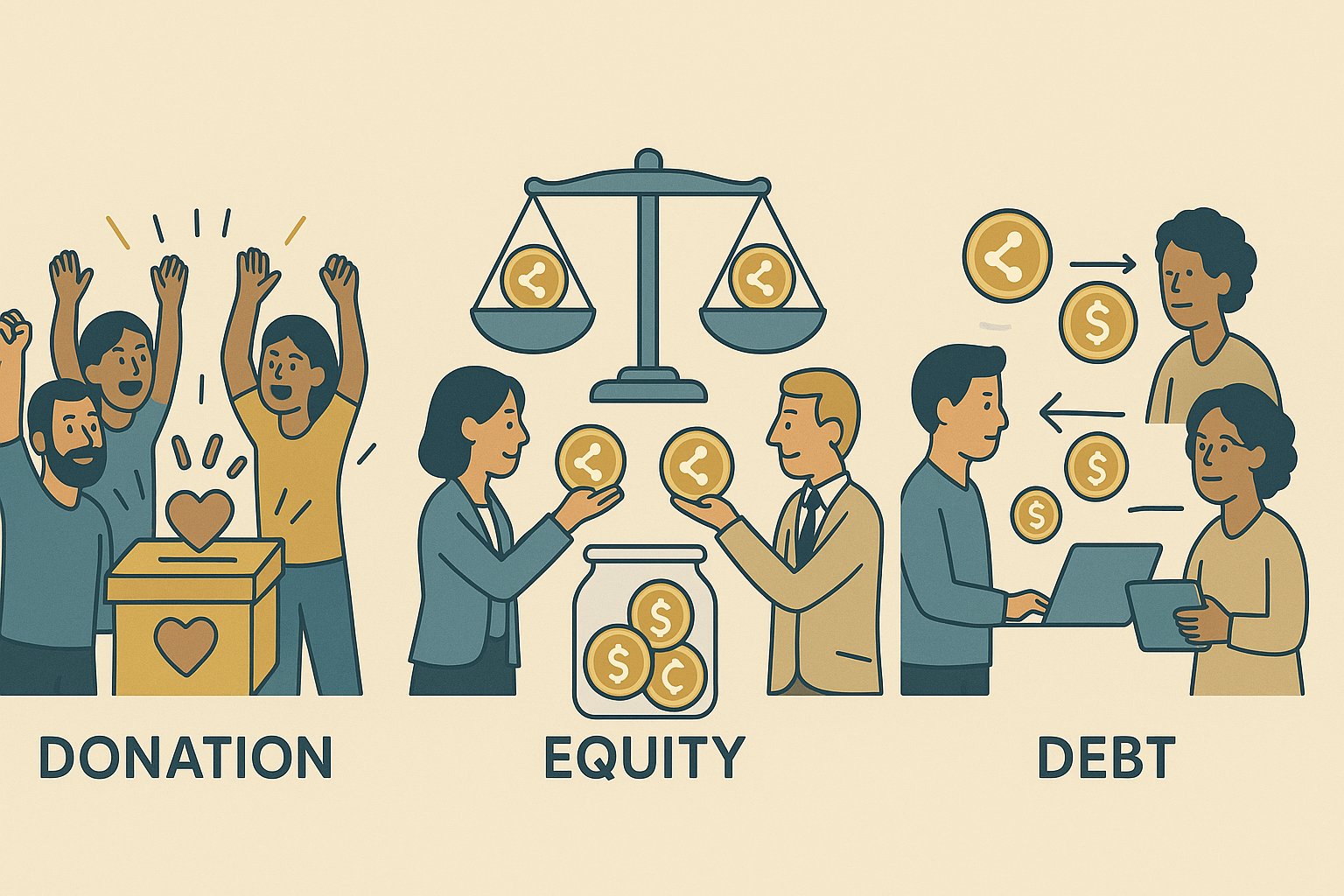Mapping the Crowdfunding Landscape
Crowdfunding has revolutionized how individuals, startups, and organizations secure capital, enabling ideas to flourish through collective participation rather than relying solely on traditional banks or venture capital. As this ecosystem has matured, five primary models have emerged—reward-based, equity-based, donation-based, debt-based (peer-to-peer lending), and royalty-based—each with distinct mechanics, benefits, and audiences. Reward-based campaigns entice backers with tangible perks or early access to products, while equity-based offerings transform supporters into shareholders. Donation-driven platforms invite pure philanthropy, debt-based services connect borrowers with individual lenders for interest-bearing loans, and royalty-based structures promise a share of future revenues. Founders and backers alike face a pivotal choice: which model best aligns with project goals, risk tolerance, and desired relationship with supporters? Selecting the wrong path can lead to unexpected obligations, operational headaches, or misaligned expectations—while the right one can amplify reach, deepen engagement, and accelerate growth. In this comprehensive guide, we’ll explore each crowdfunding approach in depth, side-by-side comparisons, real-world examples, and decision-making frameworks. Whether you’re charting a campaign launch or evaluating investment opportunities, you’ll walk away with the strategic insights to navigate crowdfunding’s vibrant frontier and maximize your chances of success.
Understanding Reward-Based Crowdfunding
Reward-based crowdfunding stands as the most recognizable form, popularized by platforms like Kickstarter and Indiegogo. Creators present a concrete project—be it a tech gadget, creative artwork, or community initiative—and offer tiered rewards in exchange for financial pledges. Early bird backers might receive a significant discount on the finished product, while higher-tier supporters gain special editions, exclusive experiences, or personalized recognition. This model excels at pre-selling products, validating market demand, and building an enthusiastic community before mass production.
The appeal lies in its low regulatory burden: creators retain full ownership and avoid securities compliance, focusing instead on marketing, prototype development, and fulfillment logistics. Effective campaigns weave compelling narratives, high-quality visuals, and clear timelines to maintain momentum. However, operational challenges can arise—manufacturing delays, shipping complexities, or underestimated costs can erode backer trust. Transparency through frequent progress updates and candid discussion of setbacks is paramount. When executed adeptly, reward-based crowdfunding becomes both a fundraising mechanism and a powerful pre-launch marketing engine that turns backers into brand ambassadors.
Exploring Equity-Based Crowdfunding
Equity-based crowdfunding transforms supporters into genuine investors by offering shares or convertible notes in exchange for capital. Platforms such as SeedInvest, Republic, and Crowdcube facilitate this approach, connecting accredited and non-accredited investors with high-growth startups. Unlike reward models, equity campaigns operate under securities law frameworks—mandating detailed disclosures, financial statements, and ongoing reporting obligations. While this adds complexity and legal overhead, it grants founders access to larger funding rounds and aligns investor interests with long-term company performance.
For investors, equity crowdfunding opens doors to early-stage opportunities once reserved for venture capitalists, offering the potential for substantial returns if a startup succeeds. Yet the risks are higher: many new enterprises falter, and investments are typically illiquid until a sale or public listing occurs. Founders benefit from the advocacy and expertise of their investor base, often gaining mentorship and valuable industry connections. The key to a successful equity campaign lies in rigorous preparation—creating a robust business plan, projecting realistic financials, and cultivating lead investors to signal credibility. Post-raise, transparent communication and governance structures sustain investor confidence and pave the way for future funding.
Unpacking Donation-Based Crowdfunding
Donation-based crowdfunding operates on the principle of pure altruism. Platforms like GoFundMe and JustGiving empower individuals, nonprofits, and community groups to raise money for medical expenses, disaster relief, educational scholarships, and other charitable causes without offering any financial return. Campaign success hinges entirely on storytelling: evocative narratives, authentic testimonials, and clear explanations of fund allocation inspire donors to contribute out of empathy and shared values.
This model’s simplicity—no rewards to fulfill or equity stakes to negotiate—makes it accessible for urgent or humanitarian needs. However, it demands unwavering transparency. Donors expect frequent updates that demonstrate how contributions are transforming lives or rebuilding communities. Leveraging social media virality and media coverage amplifies reach, turning local campaigns into global movements. Organizers must also navigate legal and tax considerations, particularly when seeking to offer tax-deductible donations through registered charities. When campaigns resonate emotionally and uphold accountability, donation-based crowdfunding can mobilize support at astonishing scale.
The Mechanics of Debt-Based Crowdfunding (Peer-to-Peer Lending)
Debt-based crowdfunding, or peer-to-peer (P2P) lending, bridges credit-seeking borrowers with individual and institutional lenders via platforms like LendingClub and Funding Circle. Borrowers apply online, undergo credit assessments powered by advanced algorithms, and receive interest rates commensurate with their risk profiles. Investors browse loan listings, allocate capital—often in small increments to diversify—and collect monthly principal and interest repayments over the loan term.
This model democratizes access to credit for those underserved by traditional banks, offering competitive rates and streamlined applications. Lenders benefit from portfolio diversification, attractive yields, and impact-driven lending opportunities. Risk management tools—such as auto-invest features, fractional lending, buyback guarantees, and robust collections processes—help safeguard investor capital. Regulatory oversight ensures proper disclosure and consumer protection, although frameworks vary by jurisdiction. By harnessing technology and direct connections, debt-based crowdfunding has become a formidable alternative to conventional lending.
Emerging Royalty-Based Crowdfunding
Royalty-based crowdfunding, sometimes called revenue-sharing crowdfunding, allows backers to earn a percentage of a project’s future revenues. Platforms like Kickfurther and Royalty Exchange cater to businesses confident in predictable sales or licensing potential—such as product manufacturers, musicians, or digital content creators. Rather than selling equity or taking on fixed debt obligations, founders pledge a share of revenues until a predetermined return cap is reached.
This alignment of incentives encourages supporters to become active promoters, leveraging their networks to boost sales and expedite royalty distributions. Founders retain ownership control and avoid traditional interest burdens, while backers gain upside tied directly to commercial success. However, accurate revenue forecasting, transparent reporting, and legal structuring of royalty agreements are critical. Companies must articulate clear terms—duration, percentage rates, and return caps—to build investor trust. Though less widespread than other models, royalty crowdfunding offers a versatile financing alternative for businesses seeking growth capital without diluting equity.
Side-by-Side Model Comparison
When evaluating crowdfunding options, it helps to consider several key dimensions: regulatory complexity, funding scale, backer expectations, risk profiles, and operational demands. The following bullet list highlights how each model stacks up against these factors:
-
Reward-Based: Low regulatory hurdles and rapid validation make this ideal for product-centric projects; operational complexity lies in manufacturing and fulfillment.
-
Equity-Based: High regulatory compliance delivers access to substantial funding and investor networks but introduces dilution and long-term governance responsibilities.
-
Donation-Based: Simplest to launch with pure altruistic contributions; success depends entirely on storytelling, social engagement, and transparent fund usage.
-
Debt-Based (P2P Lending): Offers competitive rates and predictable repayment schedules; requires robust credit assessments and risk mitigation strategies for investor protection.
-
Royalty-Based: Aligns backer returns with revenue performance without equity dilution; hinges on accurate sales forecasts and clear contractual terms.
By aligning a project’s objectives, scale, and stakeholder motivations with the model’s strengths, founders can maximize fundraising efficiency and backer satisfaction.
Key Decision Factors for Campaign Success
Selecting the optimal crowdfunding model begins with clarifying your goals and resources. If you aim to pre-sell a physical product, reward-based crowdfunding can launch sales and gather feedback simultaneously. For scalable tech ventures seeking substantial capital and strategic partnerships, equity crowdfunding may provide the growth fuel and investor network you need. Humanitarian and community causes align naturally with donation platforms, where empathy and social proof ignite generosity. Businesses requiring debt financing—such as franchise expansions or equipment purchases—find peer-to-peer lending a viable alternative to bank loans. Meanwhile, enterprises confident in projected revenues can explore royalty models to retain ownership while sharing risk. Beyond campaign type, consider audience demographics, marketing channels, team capabilities, and legal preparedness. Strong social media presence amplifies reward and donation campaigns, while email lists and investor networks boost equity success. Robust financial projections and legal counsel are non-negotiable for securities compliance. Clear communication plans, regular updates, and contingency strategies enhance backer confidence across all models. By mapping these decision factors against model characteristics, you develop a tailored roadmap that anticipates challenges and leverages core strengths.
Best Practices Across Crowdfunding Models
While each crowdfunding approach has its nuances, certain best practices transcend model boundaries. First, compelling storytelling is universal: articulate your mission with authenticity, supported by vivid narratives, testimonials, and data points. Second, transparent communication—regular progress reports, candid discussion of setbacks, and clear fund usage updates—builds trust and sustains momentum. Third, diversified outreach—combining social media, influencer partnerships, PR campaigns, and email marketing—ensures broad visibility. Fourth, community engagement transforms backers into advocates: solicit feedback, celebrate milestones together, and recognize top supporters to foster loyalty. Finally, meticulous planning—establishing realistic timelines, budgeting for fees and fulfillment, and preparing legal documentation—sets the foundation for smooth execution.
By integrating these practices into your campaign strategy—regardless of model—you cultivate an environment where supporters feel informed, valued, and motivated to champion your cause. This blend of narrative, transparency, outreach, engagement, and planning forms the backbone of any successful crowdfunding endeavor.
Future Trends in Crowdfunding Evolution
As technology advances and user behaviors evolve, new crowdfunding hybrids and innovations are on the horizon. Blockchain-based platforms promise enhanced transparency and faster settlements through smart contracts. Decentralized autonomous organizations (DAOs) may introduce community-governed fundraising pools that allocate capital based on collective voting. Subscription-style crowdfunding models—where supporters provide ongoing micro-donations or investments—are gaining traction, offering predictable cash flows for creators. Artificial intelligence tools will refine backer targeting, personalize communication, and optimize campaign timing. Impact-focused crowdfunding, integrating social and environmental metrics, will empower donors and investors to align contributions with broader sustainability goals. These emerging trends underscore the dynamic nature of the crowdfunding ecosystem. As barriers between models blur and novel structures emerge, adaptability and strategic foresight will distinguish successful campaigns. Founders and backers alike must stay informed, experiment with new features, and remain open to evolving best practices to harness the next wave of collective financing innovation.
Charting Your Crowdfunding Course
Comparing crowdfunding models side by side reveals a rich tapestry of financing options—each tailored to specific goals, audiences, and risk profiles. Reward-based campaigns ignite early enthusiasm and validate products, equity offerings attract growth capital and investor partnerships, donation platforms channel pure generosity, debt-based lending democratizes credit, and royalty structures align backer returns with revenue success. No single model reigns supreme; the optimal choice depends on your project’s nature, funding requirements, stakeholder expectations, and operational capacities. By thoroughly understanding these models, clarifying your objectives, and adopting universal best practices—powerful storytelling, transparent communication, diversified outreach, active community engagement, and detailed planning—you position your campaign for success. As crowdfunding continues to innovate, your ability to adapt and integrate emerging trends will determine the impact you can achieve. The collective power of backers awaits: choose your model, craft your narrative, and embark on a journey fueled by shared purpose and financial empowerment.




